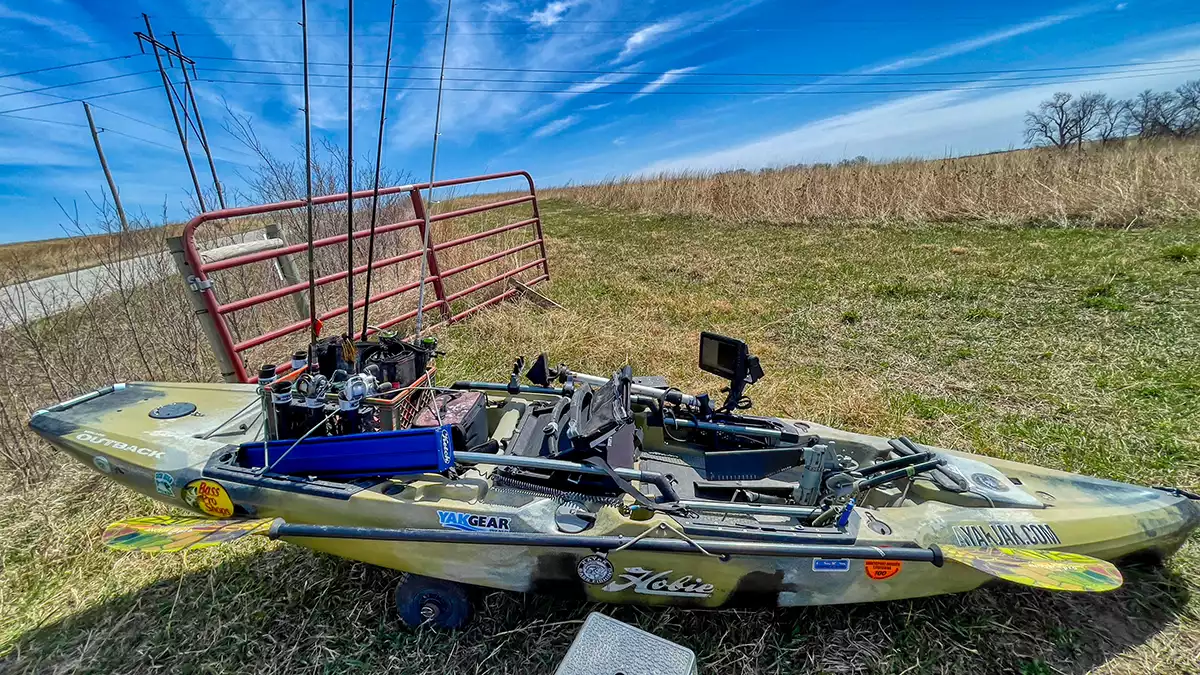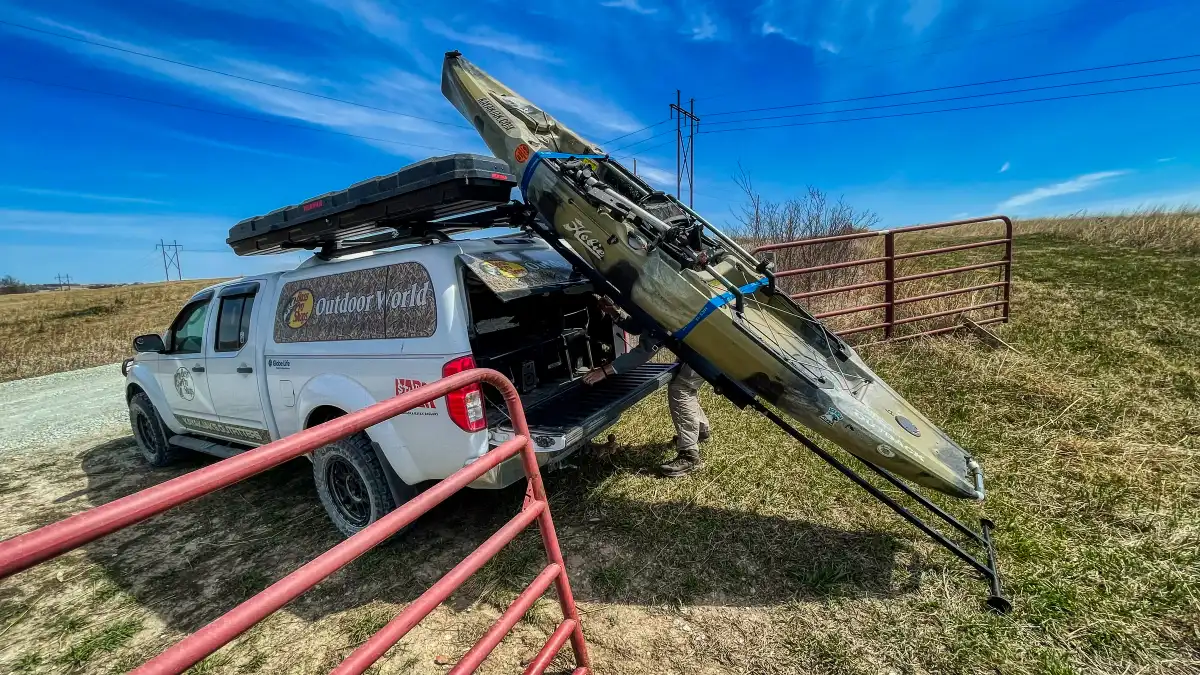In this article we cover the most important info and tips on kayak fishing if you’re new to the sport or getting back into. These kayak fishing tips will help you be more efficient and enjoy the experience a lot more as well as catch more fish. Which is what anyone just starting will want.
In 1998, I was looking for a different way to exercise without pounding my knees. I purchased a small sit inside kayak and started paddling an area lake. Flipping and getting stuck underneath the kayak was a concern. So, I wore my PFD of course, but quickly found how stable these little plastic boats can be. After getting used to the vessel, balancing was very easy, and I could quickly paddle my way into unmolested backwaters. The fish in the clear water below me were not spooked at all. So I brought my fishing combo out the next time, and the rest is history. I’ve been an avid kayak angler ever since.
More than two decades later, kayak fishing has revolutionized the ways to catch fish and explore untapped waters.
Tips for Beginners
With new anglers getting on board every day, there are some important tips I’d like to share before you venture out on the open water.
First, we must understand that there are three basic unwritten rules for kayak fishing with your safety being the priority. They include the following three things:
- Dress to swim
- Rig to flip
- Learn your centerline
At the top of the list, you want to be sure that you dress to swim. What does this mean? Well, when cotton gets wet, it’s heavy and you can get cold easily. Light water wicking clothing is best in the summer and during the colder months it is important to wear a base layer with either water repelling or wicking base layers, warm lightweight mid layers and floating vests or jackets to keep you above water and dry. I often wear my waders in the winter with a top layer over them with my PFD.
Second, be sure you “rig your fishing kayak to flip.” This doesn’t mean that you plan to flip, but rather if you do, you have secured all of your gear by attaching it by a leash, snap, or dry bag. Don’t leave things loose in a kayak because you never know when something will happen to cause you to lose balance of the boat. Always be prepared for the worst and you will never be in trouble.
And finally, for ensuring your stability, you should always keep yourself centered by keeping your head in the centerline of the boat. Once you get more acclimated to your fishing kayak, you will find your centerline quickly and easily every time. And even in those moments of excitement where you get off center, you can correct quickly.
Choosing a Fishing Kayak
There are literally hundreds of choices of fishing kayaks to purchase these days. My best advice here is to “try before you buy.” Most dealers have a demo day or maybe you have a friend that has an extra kayak for you to try out. Our Fishing Kayak Buyer’s Guide is a great place to start your search, and at least be aware of your options.
You don’t need all the bells and whistles to get started. Just be sure the kayak is a good fit for you and meets the recommendations for your size and stature. A kayak shorter than 10 feet is more difficult to track in the water. The longer the kayak, the more stable and efficient it will be on the water. A 10- to 12-foot kayak can serve most people’s needs well.
Helpful Accessories for Kayak Fishing
The paddle – Some kayak anglers are already experts at finding and catching fish while others may be experienced paddlers looking for a new addition to their time on the water. With that said, kayak angling can be considered a multi-task effort and a good paddle goes a long way to a more enjoyable outing.
Don’t feel intimidated by pedal or motor powered kayaks around you. Some of the best kayak anglers in the world still paddle and are still very successful. As for paddle length, basically, the taller you are and the wider the kayak, the longer the paddle you will need. Some outdoor sports stores are equipped with knowledgeable sales personnel to help you find the perfect paddle.
Read our article on how to choose a kayak paddle.
PFD – The most important piece of equipment would be a personal floatation device. There are basically two types of PFDs. You want to be sure that you have a properly fitted and snug personal floatation device and one that is comfortable for all types of weather. The advantage for a vest style PFD is that you can carry other essential items necessary for your safety such as a whistle, headlamp, small first aid kit, knife, line cutters, and a leash for your phone if needed.
There are lots of pockets on the vest style PFD that will hold most anything you want to bring along. The inflatable PFD is easily worn and is equipped with a small cartridge which can inflate manually or automatically when it is submerged in the water. There really are no storage compartments on this type of PFD. You never know when something unexpected might happen on the water so when paddling and fishing you should wear it all the time. Check out our article on the best kayak life jackets.
We also have an article, where we have covered all the essential kayak fishing accessories.
Launching and Loading a Kayak
Launching and landing a kayak takes some planning and skill. Most anglers seem to launch from a public boat ramp. There are pros and cons to launching from this location. The advantage is there are usually people around to help you in case something unexpected happens. The area is usually clean of debris and you can launch quickly.
One major thing to consider is that the concrete can really leave a rash on the bottom and keel of your kayak if you drag it on the ramp. More and more anglers are finding remote places at lakes to launch all the time. One thing you want to be sure of is to have your kayak stern in the water when launching from a small ledge. I’ve seen a lot of kayakers flip before they even get the whole kayak in the water.
You can enter your kayak from the side or simply walk into the water to get into it with appropriate footwear or waders in colder water.
Loading a kayak can be a bit of a challenge with larger kayaks. There are lots of great loader systems and accessories for hauling kayaks on the market now. I use one developed by a friend years ago and I can unload and assemble my kayak and be fishing in about 5 minutes. Same for putting it back on top of my truck. Loading takes a lot of consideration and is always easier with two people.
We also have detailed articles on how to transport a kayak and a buying guide for the best kayak racks.
Bass Fishing From a Kayak
The biggest allure to kayak fishing is getting to places that hold fish who have never seen a lure. Just starting out, you might take along one combo and a bait you have a lot of confidence in using to catch fish. That first tug will have you hooked for life! Once you get a hook up, even a big bluegill can move your kayak. If you get a big fish, be prepared for a ride.
One thing to remember is that you are just about level with the water and fighting a fish at this level is even more invigorating. One way to get the fish into the boat is a net but if you keep out a length of line that is the length of the rod, you can easily hold it in the opposite hand and grab the fish with your dominate hand.
Remember that once you stop paddling, there is the “drift” factor where the kayak is still moving. You want to stop paddling before you get to your casting spot and then continue to manipulate the kayak in the position you want to lineup for the cast. Boat position takes a little practice to master but it becomes second nature quickly.
One rod, a few lures. A combo you are comfortable using and a few confidence lures will put fish in the boat. If you are going for bigger fish, you might bring a net along as well. Basically, throwing those lures into areas you feel might hold a bass will give you a chance to experience that tug which will send a jolt of adrenaline through you every time you hook into a fish!
That’s really all you need to focus on at first. Don’t try to bring a whole garage full of lures. Bring the staples for the season. If it’s warm weather, worms and plastics as well as topwaters can be good. If it’s colder weather, jigs, crankbaits and jerkbaits are good. A ChatterBait is good all the time. As you progress there are a lot of great options for regular success in kayak fishing.
Other Species
Check out our other articles, for more species-related content:
More Kayak Fishing Tips
To be effective and catch more fish from a kayak, you need to master your paddle or propulsion. Your paddle on one side or the other will propel and turn the kayak slightly and same for paddling backwards. So you will learn to pivot and turn easily and also to get a steady flow going to move from spot to spot. With a pedal drive you can free up your hands more to fish and move simultaneously.
A kayak gets you in to those off the road places like ponds, small lakes with no access, streams and creeks as well as small sections of larger bodies of water. You can be way more stealthy in a kayak than a big boat and even walking the bank. So use that to your advantage to get to fish no one else can. And those are often the easier fish to catch. So do some research and find water near you that has been hard to access without a kayak.
Learn to be stealthy with your casts and retrieves too. Don’t make too many big moves that wobble the kayak and create small pressure waves. You’re low to the water so you can skip easier and you can make low, quiet casts. I like frogs, Texas rigged plastics and Neko rigs for fishing from a kayak and recommend those baits to a lot of newbies starting out.
It can seem daunting in the beginning, but get out there and practice when the water is warm and you’ll have it down in just a trip or two and get more proficient with every part of kayak fishing the more you go. It’s a great source of relaxation, exercise and great bass fishing if you can find small bodies of water close by.
















